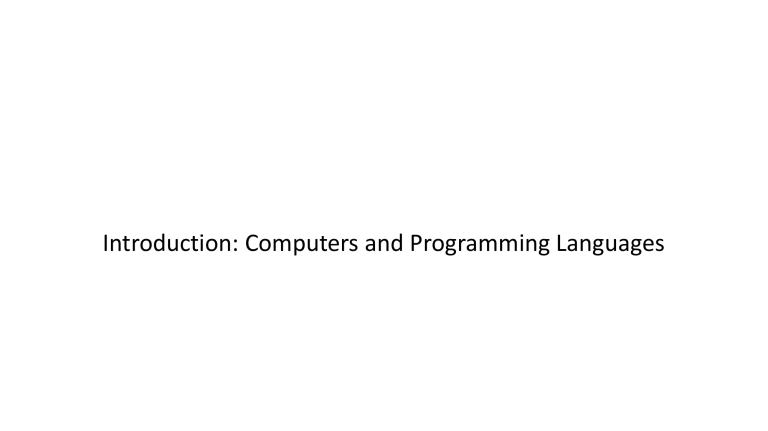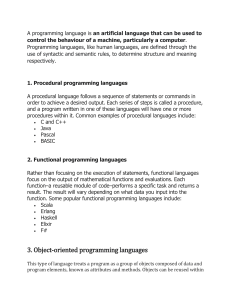
Introduction: Computers and Programming Languages Today… • Introduction (~70 minutes): • • • • Motivation Hardware basics High-level vs. low-level programming languages Compiling vs. interpreting high-level languages • Adminstrivia (~10 minutes): • Course overview Computers and Programming • A computer is just a machine (the hardware) for executing programs (the software) • Hence, the software rules the hardware! • The process of creating software is called programming, and it is the focus of this course • Virtually, anyone can learn how to program computers • It requires only some grit! Why Learn Programming? • Computers have become commonplace in our modern life • Understanding the strengths and limitations of computers requires some understanding of programming • Programming can be loads of fun! Ubiquitous Astronomy • It is an intellectually engaging activity thatComputing allows you to express yourself through remarkably beautiful creations Smaller, Faster, Cheaper Sensors • Programming develops valuable problem-solving skills, especially ones that pertain toGene analysis, design and implementation Sequencing and Biotechnology • Programmers are in great demand! Why Learn Programming? • Computers have become commonplace in our modern life • Applying ideas in different fields requires programming • Programming can be loads of fun! • It is an intellectually engaging activity that allows you to express yourself through remarkably beautiful constructs and structures • Programming develops valuable problem-solving skills, especially ones that pertain to analysis, design and implementation • Programmers are in great demand! Programming Languages • A program is just a sequence of instructions telling the computer what to do • Obviously, we need to provide these instructions in a language that computers can understand • We refer to this kind of a language as a programming language • Python, Java, C and C++ are examples of programming languages • Every structure in a programming language has an exact form (i.e., syntax) and a precise meaning (i.e., semantic) Machine Languages • Python, Java, C, and C++ are, indeed, examples of high-level languages • Strictly speaking, computer hardware can only understand a very lowlevel language known as machine language • If you want a computer to add two numbers, the instructions that the CPU will carry out might be something like this: High-Level to Low-Level Languages • In a high-level language like Python, the addition of two numbers can be expressed more naturally: c=a+b Much Easier! • But, we need a way to translate the high-level language into a machine language that a computer can execute • To this end, high-level language can either be compiled or interpreted Compiling a High-Level Language • A compiler is a complex software that takes a program written in a high-level language and translates it into an equivalent program in the machine language of some computer Source Code (Program) Compiler Machine Code Inputs Running Program Outputs Interpreting a High-Level Language • An interpreter is a software that analyzes and executes the source code instruction-by-instruction (on-the-fly) as necessary Source Code (Program) Inputs Computer Running An Interpreter • E.g., Python is an interpreted language Outputs Compiling vs. Interpreting • Compiling is a static (i.e., pre-execution), one-shot translation • Once a program is compiled, it may be run over and over again without further need for the compiler or the source code • Interpreting is dynamic (i.e., happens during execution) • The interpreter and the source code are needed every time the program runs • Compiled programs tend to be faster, while interpreted ones lend themselves to a more flexible programming environments (they can be developed and run interactively) Summary • Programs are written using a formal notation known as a programming language • There are many different languages, but all share the property of having a precise syntax (form) and semantics (meaning) • Computer hardware only understands a very low-level language known as machine language • Programs are usually written using human-oriented high-level languages such as Python Summary • A high-level language must either be compiled or interpreted in order for the computer to understand it • High-level languages are more portable than machine languages • Python is an interpreted language • One way to learn about Python is to use an interactive shell for experimentation




